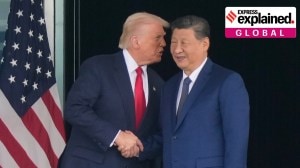CZECH,PLEASE!
Travel brochures regularly refer to Prague as one of Europes most charming cities. We find no reason to disagree
Travel brochures regularly refer to Prague as one of Europes most charming cities. We find no reason to disagree
A janitor at the railway station was my first guide. He was followed by a ticketing clerk and then a student from Brazil I happened to chat with on the Metro. Together,they helped me find my hotel in a new part of town called Vysehradallegedly the location of the first settlement that later became Prague. It was no easy task,considering I had arrived at their beautiful city a little after 11 pm. Armed with the English language (now spoken by approximately 1.8 billion),I stood dazed,luggage in hand,grappling with the West Slavic Czech spoken by just about 12 million. For the first time in years,I felt unarmed. The funny thing is,it also felt mildly liberating.
The Russian owner of my hotel was the next surprise. As I staggered into his domain at midnight,he welcomed me with a shout. Indian friend,I thought you lost! All I could do in the face of his exuberance,despite the awkward grammar,was smile and ask,as awkwardly,for a shot of vodka. A half -hour later,he was complaining to me about how corrupt politicians were ruining his country. I asked him,politely,to join the club.
Over the coming days,the list of surprises grew. Greeting people in basic Czech got me smiles. I was stopped on the street by a couple of strangers who had questions about India. Cobbled paths ended abruptly with views of the ancient river Vltava,populated by swans. And despite the fairly large number of tourists jostling for space at the more popular attractions,I still felt my jaw drop a few times at the sheer picture-postcard moments featuring cathedrals,walled courtyards,and the odd tower tipped with goldstrewn liberally throughout the 1,000-year old city.
In retrospect,I realise much of Pragues beauty came simply from the fact that,unlike many parts of Europe,it was relatively undamaged by the violence of World War II. The city centre managed to astonish tourists because it came across as an antique showpiece. It was like walking into a museum and being confronted by regular folk in homes that looked much like they did centuries ago. Nowhere was this more obvious than at the Prazsky Hrad (Prague Castle) or the Karluv Most (Charles Bridge).
Although the former was the citys biggest attraction,it took me a while to locate it. Its spires were visible for miles,but the streets surrounding it held little information that could help. Eventually,all I could do was follow a few tourists. Currently the seat of the Czech president,the castle was formerly home to the King and was supposedly Europes oldest. It looked it.
Even better,however,was the bridge located a short picturesque walk from the castle. Built in 1357 under the patronage of King Charles IV,it finished crossing the Vltava only by the beginning of the fifteenth century. Lining either side of it were baroque statues of saints. The thing I found most interesting leaving aside the structures history,and its stunning Old Town bridge tower was a legend that maintained its sandstone was enriched with eggs to bind and make the stone blocks harder. Apparently,recent laboratory tests had proved this to be true.
Thanks to the humble egg,the bridge had survived massive floods (the last as early as 2002,which came close to destroying parts of Prague),a 30-year war,horse carriage traffic,electric trams and modern vehicular traffic. Now here it was,crawling with twentieth-century tourists,populated by souvenir-sellers,popping up in music videos for Kanye West,and making appearances in Hollywood blockbusters like s. It was a rather strong argument for eggs.
On the day I was to leave,I walked through Vaclavske Namesti (Wenceslas Square),the cultural heart of the city. Named after the patron saint of Czech lands,it was a spot much loved by locals. Near a big statue of Wenceslas on a horse is where a student called Jan Palach set himself ablaze in 1969,protesting the Soviet occupation of Czechoslovakia. It was a reminder of Pragues violent communist past. These days,the statue served as a meeting point. You could ask a friend to wait near the horse,apparently,or pod ocasem under its tail.
Later that day,after slinging my bags over my shoulder,I walked out of tshe Hotel
Vysehrad. Come back soon, my new Russian friend shouted. I nodded vigorously.
HOW TO GET THERE:
The city centre is a half-hour car ride from Ruzyne international airport. I entered by train,via international station Hlavni Nadrazi,before opting for the efficient metro service.
WHAT TO SEE
Buy a Prague card,valid for four days and offering free entry to over 50 attractions. Also,stop by one of many pubs,or hospoda,for some economically-priced local Pilsner.
WHAT TO BUY
Old Town is the best place for souvenirs. The problem is,locals know this too,so expect mass-produced goods like T-shirts and refrigerator magnets. If you can,pick up some genuine Bohemian crystal.



- 01
- 02
- 03
- 04
- 05




























